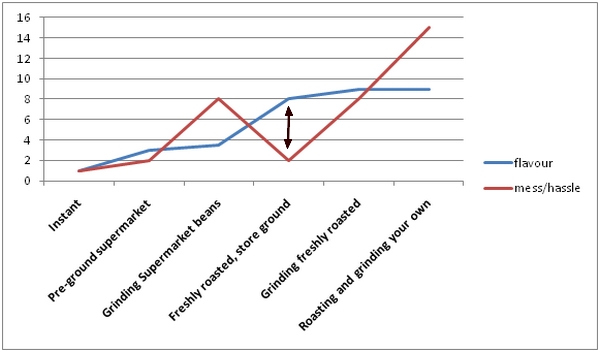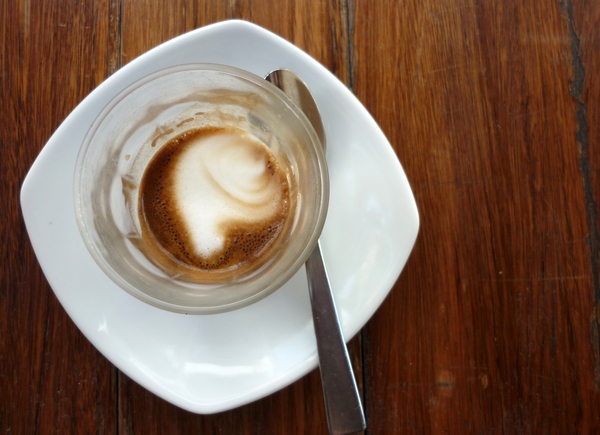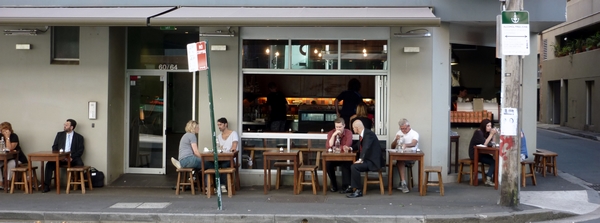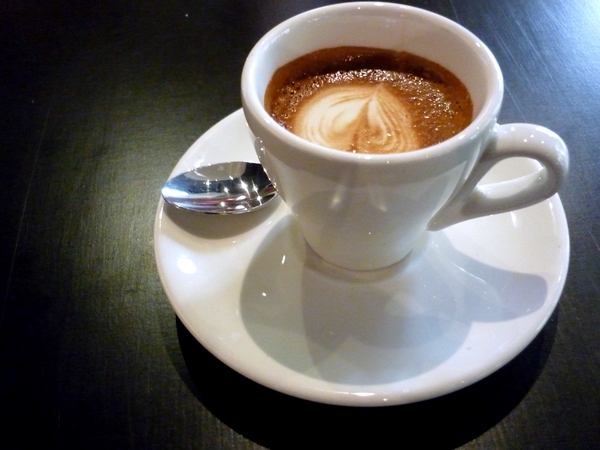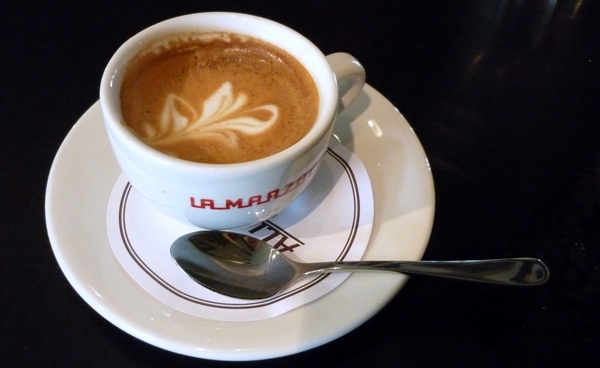I have a shameful secret to reveal. I don’t grind my own coffee.
Being a barista (well, not right now), this has sometimes led to a questioning of my coffee expertise, something along the lines of ‘Well, if you can’t taste the difference, I guess it’s no big deal.’ Oh, clever, I see what you did there. A little passive-aggressive jibe not at only my expertise, but at my actual sense of taste! Nice one. Then there’s the more overt ‘how can anyone who doesn’t grind their own beans know anything about coffee?’

Actually, I know great deal about coffee, definitely more than nothing. And it is this knowledge, along with my own personal circumstances, that has led me to drink it the way I do. First world problems, eh? Here are the 4 steps of reasoning that lead me to believe a grinder is not for me.
1. The ‘scale of flavour’ is a myth
Firstly, I call into question that there is one perfect coffee bean out there that, when perfectly ground and extracted, will yield perfect results for everyone. It has been proven that the majority of people like a light, caramel roast and there’s also a chunk that prefers a dark roast, so that in itself blows that idea out of the water. But let’s take a look at this imaginary scale anyway:
The perfectionist’s scale:
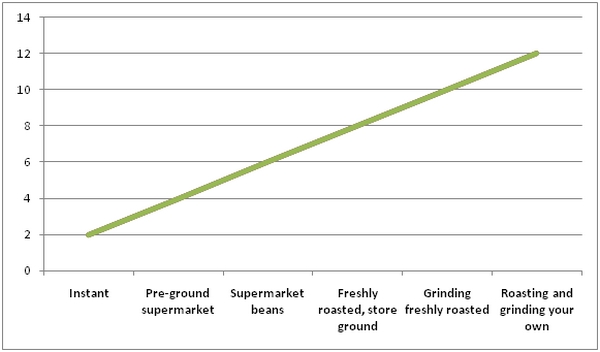
Now I have a billion issues with this graph. First, if this were the scale, how would the coffee machine factor in? What if you used French press, a $100 espresso machine, a $1000 espresso machine, stovetop, hot water, cold water extraction, syphon… the list goes on. What about skill? What about mistakes? What about how much coffee you have to throw out whenever you grind it wrong? There are too many variables, so let’s just look at two – flavour and mess/hassle.
2. Flavour vs. Effort. That’s my scale.
In this diagram, the blue line represents flavour and the red line represents mess/hassle.
Notice I’ve given pre-ground supermarket coffee a 2 for flavour, store-ground boutique coffee an 8 for flavour, and boutique beans a 9. So you’d think the beans are the natural choice. But not so, because grinding beans has a mess/hassle score of 8 which is quite high, where getting a store to grind it with a commercial grinder is a 2. What I’m looking for is a large gap between mess/hassle and flavour, with flavour at the top. Thus, store ground boutique coffee has a score of 4 (8/2) and boutique beans get 1.125 (9/8). That’s my reasoning.
3. I have skills, I don’t need gadgets.
The truth is I don’t need a graph, but I drew it to make a point- there is not an absolute value for flavour. There are standards. There are better methods and worse methods. But there is also what works for you. At the end of the day, I don’t own a grinder because it just isn’t that important to me, and I’m drinking much nicer coffee than a lot of people who do. It’s my theory that just as a poor tradesman blames her tools, a poorly skilled one buys fancy tools to make up for that lack of skill. And it doesn’t work.
4. Other factors
Of course there are other factors. The fact that I live in inner-city Sydney, surrounded by coffee roasters and great cafés is one of them. The fact that I am a trained barista is another. A kitchen the size of a built-in wardrobe is another – there’s no space for a grinder. And there’s a whole other issue as well, which is that the more complex the method, the more crap you are talked into buying, and buying stuff is not one of my favourite activities. But either way, my graph still stands. Because science.
What about you? Have you come up against any first-world-type judgements lately? Maybe you didn’t deglaze a pan properly? Maybe you don’t eat organic, or don’t breast-feed your child? Tell me about an occasion your common-sense reasoning was undermined by hipsters. Sock it to me, chums.
We’ve all been there. Eagerly awaiting that fist sip of coffee only to find a disappointing brew that can only be described as ‘that’s not what I ordered.’ It’s all too easy to criticise, saying you asked for ‘extra hot’ or ‘strong’ or ‘not too much froth’ but these are subjective terms. Wouldn’t it be lovely if someone would give you a user’s manual for the wank-fest that is coffee these days? Well, somebody has. Here are the five simple rules to get not only the correct coffee, but the best.
1. If you don’t want sugar, never, ever ask for ‘no sugar’.
I know many people do this to pre-empt the irritating, automated query that comes free with any takeaway coffee almost immediately after you’ve placed your order: ‘any sugars’? However, in a crowded, noisy coffee shop, no matter how good the barista’s ears, ‘no sugar’ almost always sounds like ‘one sugar’ and that’s what you will get, which will annoy you no end.
The reason every customer gets asked ‘any sugars?’ is to save us all from that all too common moment after a customer receives their small cap and asks ‘did you put the sugar in?’ and then the barista has to take the coffee, open it, add the required number of sugars, stir and re-lid it. This makes no sense at all because HOW ON EARTH WOULD THEY KNOW HOW MUCH SUGAR TO PUT IN?! So undergo the annoying automated query. You are saving, not wasting time.
2. Don’t leave the coffee shop, either literally or mentally.
It’s a bad idea to talk on your phone, listen to your mp3 player or just not listen for your order. It’s an even worse idea to expect to be served while you’re actually talking on your phone. This ensures grumpy service and its likely you’ll end up with the wrong coffee.
Although the number of people who take the wrong coffee is pretty miniscule it is hugely annoying, not only for the person who does it but for the customer who has to wait for a new coffee and for the barista who has to make their coffee all over again. Listening out for your order assures this won’t happen, as does keeping an eye on who ordered before you. Chances are when they collect their coffee, you’re next.
3. Know your order
It sounds so obvious, but you’d be surprised how many people don’t know what they order. I once had a guy come in and order three coffees: a macchiato and two lattes. What he actually wanted was a mug of cappuccino and a mug of long black. He didn’t even know how MANY coffees he wanted.
In a lot of cafés, the staff know all their regular customers’ orders. But if there is ever a new staff member who doesn’t know your order or you change cafés, you need to know what it is you order. So when someone asks you ‘what would you like today?’ it is not at all helpful to say ‘She/he knows’ or ‘my usual’ if you have never in your life seen the person standing in front of you.
4. Expect the barista to know what the coffee they just made is. Don’t expect them to know whose it is.
Once your coffee is made, if the barista yells out ‘large caramel cappuccino with two equals’ and that’s what you ordered, there’s not much point in asking ‘is that my coffee?’. The barista, in a flurry of making 25 coffees at once, will have no idea, he/she will only know what the coffee is as he/she most likely did not take your order. If you’ve been paying attention, you’ll notice the person who ordered before you just grabbed their coffee so it must be yours. Or you might notice you are the only person left in the coffee shop. Or you might notice that your order is so incredibly unique that no one else could have ever dreamed it up. A large-strong-half-skim-half-full-cream-Chai-latte-no-cinnamon-on-top-extra-hot, for example. That’s yours for sure.
5. Want stronger coffee? Reduce milk, don’t add shots.
The cheapest way to strengthen coffee is to reduce the amount of milk, not add more coffee shots. This little-known secret also inadvertently leads the barista to take your request more seriously. Why is this? Well, it’s because by asking for a small ¾ full cappuccino instead of a double shot small cappuccino, you are being particular and your order is memorable. This means that the barista knows if they get your coffee wrong you’ll return it, and so, to avoid this, they’ll make exactly what you asked for. You’ll also get their full attention so there’s less chance of mistakes.
So there you go. Truly, it is knowing how not to order your coffee that is the key to a) receiving what you ordered and b) it tasting delicious. Why? Well, a) because the barista will have a clear understanding of what you want and b) they will go out of their way to give it to you.
I bet you’ve all got something to say about café etiquette. What really irks you, chums?
About me
 Sharing easy recipes, hunting down the best coffee. Honest accounts, nothing too serious. Read more...
Sharing easy recipes, hunting down the best coffee. Honest accounts, nothing too serious. Read more...Recent Posts
- Aerpress means no more shit #travelcoffee and #workcoffee
- Why I write and four ace bloggers who do it better
- The five best things I ate in London
- Shoreditch is awesome, airports are not
- I quit sugar? Do I bollocks.
- Cubao Street Food, Alexandria
- The Reformatory Caffeine Lab, Surry Hills
- Brewtown Newtown
- Stay caffeinated over Christmas
- Gumption by Coffee Alchemy, Sydney CBD
Popular posts this month…
 The quest for Mex part 2 – Feisty Chicken Burritos posted on December 21, 2010
The quest for Mex part 2 – Feisty Chicken Burritos posted on December 21, 2010  Sparkling Long Black posted on May 10, 2011
Sparkling Long Black posted on May 10, 2011 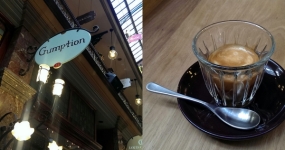 Gumption by Coffee Alchemy, Sydney CBD posted on December 13, 2013
Gumption by Coffee Alchemy, Sydney CBD posted on December 13, 2013  Review – Philips Saeco Intelia posted on January 10, 2012
Review – Philips Saeco Intelia posted on January 10, 2012  Salat Hatzilim posted on January 28, 2011
Salat Hatzilim posted on January 28, 2011  Eat. Drink. Blog. Dinner at Kingsley’s Steak and Crab House, Woolloomooloo – 5 November 2011 posted on November 11, 2011
Eat. Drink. Blog. Dinner at Kingsley’s Steak and Crab House, Woolloomooloo – 5 November 2011 posted on November 11, 2011 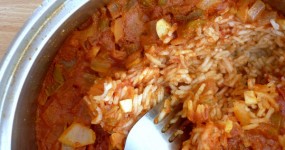 The quest for Mex part 1 – Mexican Red Rice posted on December 17, 2010
The quest for Mex part 1 – Mexican Red Rice posted on December 17, 2010 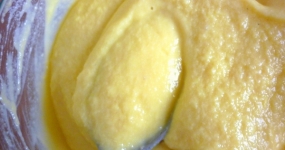 Rich Portuguese Custard posted on November 29, 2010
Rich Portuguese Custard posted on November 29, 2010
Disclaimer:
All opinions in this blog are mine, an everyday, real-life person. I do not accept payment for reviews and nor do I write sponsored posts. I do not endorse the content of the comments herein.

